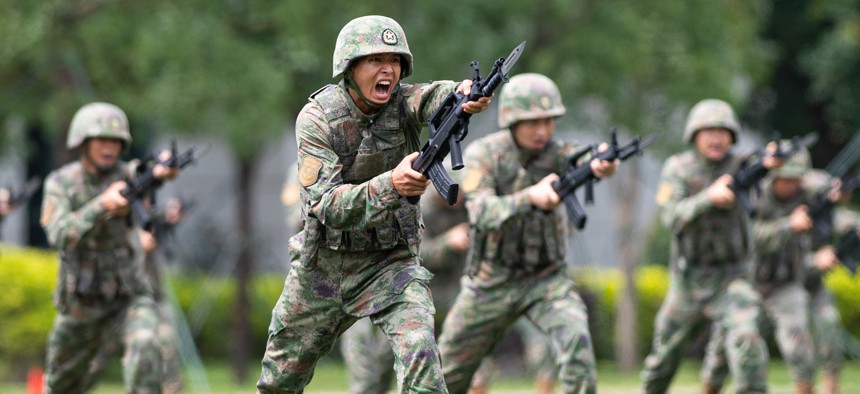
Soldiers of the Chinese People's Liberation Army Garrison stage military exercises during an open day event at the barracks on Taipa Island in Macao, China, April 30, 2023. Cheong Kam Ka / Xinhua via Getty Images
China is using US-allied exercises to find ‘soft targets’: US Army’s Pacific chief
The PRC is on a “very, very dangerous path,” Gen. Charles Flynn said.
Chinese jets flying near Taiwan and Chinese fishing vessels swarming off the Philippines may get the headlines, but China is also conducting aggressive acts beneath the threshold of armed conflict on land, the head of U.S. Army Forces Pacific said Wednesday.
China has been closely monitoring U.S. exercises with regional partners such as Indonesia and the Philippines as they grow in size and scope, Gen. Charles Flynn said at the Irregular Warfare Forum in Virginia.
“They go relatively dormant during a key period of the exercise and then after it's over they'll go find soft targets. They'll find officials to broker a deal with and then they'll maybe look for some land around one of the key bases or locations where we train,” Flynn said. “So I'm trying to describe to you that these are ground intercepts that happen all the time.”
These operations aim to gather information about how the U.S. might fight a Pacific war, but they also seek ways to drive wedges between Washington and its regional partners, he said.
“The Chinese are trying to disassemble, fragment and fracture a network of allies and partners that the United States enjoys globally, but definitely in the Indo-Pacific. And they're working every day.”
Flynn said that China was on a “very, very dangerous path. The PRC’s immediate goal: prepare the operational environment for seizure of Taiwan, full stop. I believe [Chinese President Xi Jinping] is evaluating four things when determining…go or no-go criteria,” he said.
“First, can they withstand international sanctions? Secondly, they are doubling down on fragmenting, fracturing, and disassembling the network of the allies and partners that the U.S. enjoys in the region…Thirdly, he's evaluating the skill and the military proficiency of his leaders to be able to pull off a highly complex operation across [the Taiwan] strait. And fourth, he has to win the information war. He's got to make sure that China is seen as a reliable and rising power and the United States and the West, a declining and faltering power.”
The U.S. Army and its partners can monitor and respond to many of those actions, especially those that are less obvious than a jet intercept or risky naval maneuver, he said.
One of the Army’s Multi-Domain Task Force Teams in the Pacific recently combined nine information threads. including open source, to provide a fuller picture of “everything that's out there moving in the air and maritime…everything that's that can be seen on the terrestrial face of the earth. They pulled these applications together. Basically put a, I’ll say, a maritime littoral and air littoral common operating picture on the ground.
“So now a country can look at that and say, ‘Why is there activity over here, no activity over there?’ And then begin to—with precision—move assets, whether it's an unmanned asset, or if they want to send one of their vessels over there to go investigate. Or maybe they're already getting reporting about it. This is how we, in the land domain, can pull together a common operating picture to be able to see sense and make sense of actually what's happening.”
